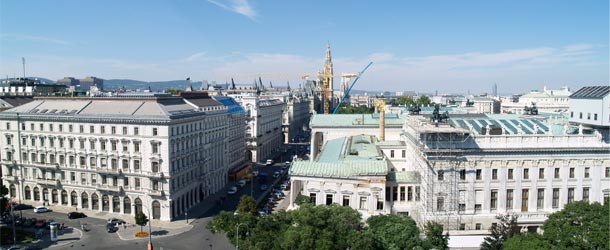Book your place on any Danube river cruise and you’re guaranteed of the chance to experience Vienna, one of Europe’s most beautiful and culturally rewarding cities. As soon as you set to exploring, you’ll see why the city is so popular with visitors and residents alike. It regularly scores highly in polls on the best place to live in the world and has come out on top in human resource consultancy Mercer’s survey on Quality of Living no less than four years on the run. It’s a place that’s truly alive; historic, yet thoroughly in touch with contemporary culture, boasting iconic buildings and beautiful architecture but full of intimate charm, through any number of welcoming cafes and restaurants.
Vienna is of course, the capital of Austria and its largest city, being home to around 20 per cent of the country’s population. The first people to settle in the area today known as Vienna were the Celts in 500BC and since then it has played a prominent historic role. Throughout the Middle Ages it was home to the Babenberg Dynasty, became the Habsburg’s resident city in 1440 and became the capital of the Austrian Empire in 1804, after which it continued to play a leading role on the world’s political stage. In the late 19th century and first part of the 20th, Vienna enjoyed a reputation as one of the world’s leading cultural cities due to its hugely significant contribution to the arts. Today, its historic city centre bears witness to its rich past and boasts some truly breathtaking architecture and is a dedicated UNESCO World Heritage Site. Enjoying a rich musical pedigree, it’s often referred to as the city of music and such master composers as Mozart, Beethoven, Haydn, Schubert and Brahms have all worked in Vienna.
What not to miss
As with any major European capital, there’s easily enough to keep you busy for at least a week in Vienna, but here’s a guide to just some of the city attractions not to be missed when you visit the city as part of your river cruise experience.
St Stephen’s Cathedral
Located at Stephansplatz, this beautiful Catholic cathedral is the city’s leading tourist attraction and remains its most recognisable landmark, thanks to its distinctive twin towers and strikingly multi-coloured tiled roof. Like many religious buildings of long standing it’s had a turbulent history and after being consecrated in 1147, it was destroyed by fire in 1258. Its gothic replacement survived both a Turkish siege in 1683 and the ravages of the Second World War, after which it was completely repaired. The beautiful exterior is an attraction in itself but the interior boasts some beautiful architecture and altarpieces. You can also climb the north tower, which is home to one of the world’s largest bell and explore the atmospheric catacombs, too.
Vienna State Opera
It’s only fitting that, as a city with such a strong musical heritage, Vienna is home to one of the world’s most famous opera houses. Completed in 1869 in the Neo-Renaissance style, it’s a joy to behold and boasts a beautiful interior, which you can experience by way of a guided tour, when you’ll hear all about the building’s history and even go up on stage to tread the boards yourself. Another way to really soak up the ambience is of course to attend a performance and while it’s advisable to book in advance to secure the best seats, a large number of standing room tickets are available for as little as 4 euro, an hour-and-a-half before each performance starts.

Hofburg Palace
Home over the years to some of the most influential people in European history, the imperial palace today serves as the Austrian president’s official residence and thus is one of Vienna’s most important buildings. The former winter residence of the Habsburg dynasty, it has been a seat of government since 1279 and is a truly impressive building. A number of celebrated architects have contributed to its expansion over the years, when the Imperial Library, museums, national theatre and riding school were added. Today, visitors can explore the rich history of the building and the opulent lifestyles of its past inhabitants by way of its fascinating museums.
Kunsthistoriches Museum
Situated on Maria-Theresien-Platz in Vienna’s famous Ringstrasse, the city’s most important fine arts museum is a hugely impressive building in its own right and companion museum to the Naturhistorisches Museum, sharing an identical exterior with it. Inside you’ll find the spectacular art collection amassed by the Hapsburg Dynasty over the years, boasting everything from Egyptian artefacts and Roman antiquities to coins and fine art. The museum’s picture gallery is an art lover’s delight, boasting a large and varied collection of works, including paintings by such iconic masters as Raphael, Rubens, Rembrandt, titian and Caravaggio.
Schonbrunn Palace
Or Schloss Schonbrunn, as it is also known, is a popular choice for a day trip outside the city, as an alternative to exploring the city, or perfect if you’ve more than a day to spend in Vienna. The former summer residence of the Habsburgs, it remains one of the city’s most popular tourist attractions, thanks partly to its beautiful garden complex, which is free to explore. When it comes to exploring the palace itself, a shorter imperial tour will give you the run of 22 rooms or you can book a complete, 40-room tour. As you would expect, it’s a fascinating experience and some of the interiors are quite beautiful, such as the Great Gallery and the Millions Room.
By Simon Brotherton
Google



